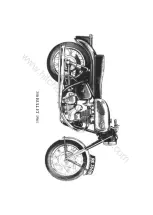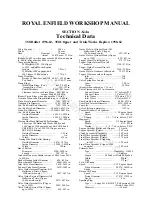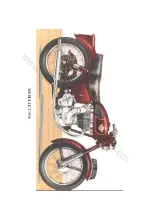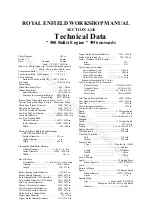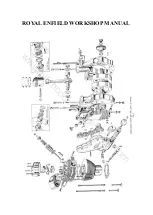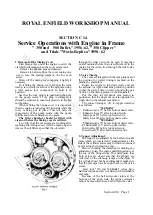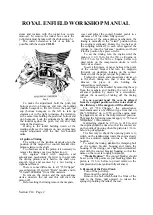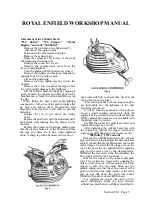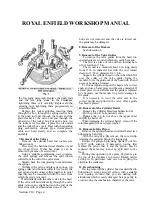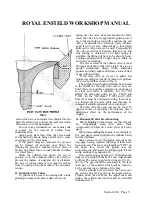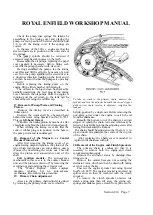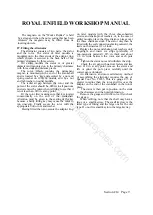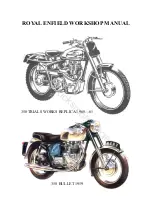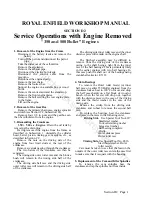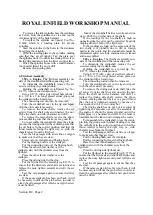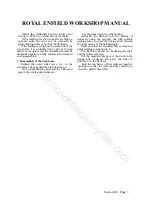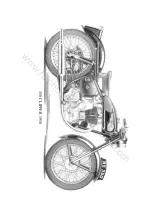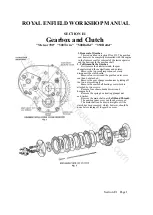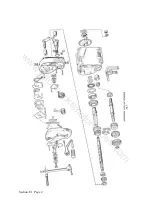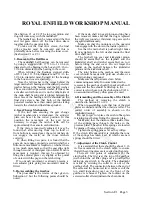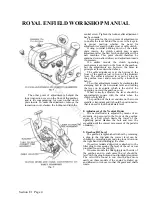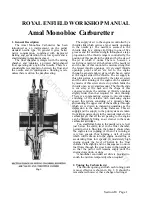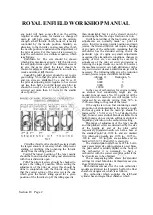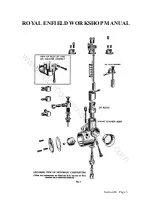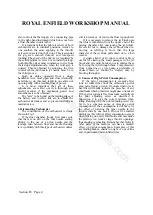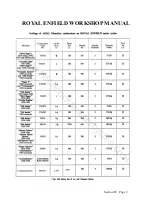
ROYAL ENFIELD WORKSHOP MANUAL
Section C14 Page 8
retaining ring and the assembly of driving and
driven clutch plates. The clutch sprocket can then
be withdrawn from the centre after removal of
the large circlip which secures it.
21. Removal of the Tappets and Guides
It is only necessary to remove the tappets and
guides if they have become worn.
To remove the guides use Special Tool No.
E.5410.
The guide should have an interference fit of
.0015 in. to .0025 in. in the crankcase and can be
driven in with a bronze drift, care being taken
when the guide is nearly home to avoid damaging
the collar. Excessive hammering may close up the
bore of the guide which would necessitate
removing the tappet and reaming again. In no
circumstances should the guide be reamed in
position on the 350 c.c. engine as swarf might get
into the recess in the guide.
22. Dismantling the Breather
If the breather is not operating efficiently, it
may cause pressure in the crankcase, instead of a
partial vacuum, giving rise to smoking or
overoiling. If the breather is of the disc type, see
that the discs and backplate are clean and
undamaged and that the discs are seating
properly.
When reassembling the breather, apply
jointing compound very sparingly to the back of
the steel plate taking great care to keep it away
from the discs or their seatings.
If the breather is of rubber tube type, there
are no moving parts and it is only necessary to
see that the tube is not damaged or distorted.
If the breather body is detached from the
driving side crankcase by removing the three
screws, see that the faces are clean when refitting
and apply jointing compound to ensure that the
seal is airtight.
23. Removal of the Clutch
Remove the engine sprocket and clutch
sprocket together as described in Subsection 20.
To remove the clutch centre, hold the clutch
with Special Tool No. E.4871, and remove the
centre retaining nut and washer with a box
spanner.
The clutch centre can then be withdrawn from
the shaft with Special Tool No. E.5414.
If the circlip is not removed the sprocket and
clutch centre can be removed together.
24. Removal of the Final Drive sprocket
Remove the clutch as described in Subsection
23.
Remove the primary chain tensioner
Remove the rear half of the primary chaincase
by taking out three socket screws.
Remove the grub screw locking the final drive
sprocket nut.
Hold the sprocket and remove the nut (right
hand thread) The sprocket can then be
withdrawn.
25 Pressure Relief Valve
There are two pressure feeds to the big end
and to the rocker gear respectively. Their function
is to prevent excessive pressure and their setting is
not critical. The feed to the rocker gear comes
from the return oil from the crankcase to the tank.
The pressure relief valves are set before leaving
the Works and should not normally require to
disturbed. If, however, it is found necessary to
dismantle either of them, they can be reset as
follows.
Rocker Feed Relief Valve. This is located on
the outside of the crankcase immediately below
the lower end of the external oil pipe. It has a
hexagon head and can be removed complete by
unscrewing it out of the case.
The valve itself cannot be dismantled and if
found to be faulty, should be replaced by a new
one.
Big End Relief Valve. This is located in the
timingside crankshaft and can only be adjusted
when the crankshaft has been dismantled. It
consists of a 5/16 in. diameter steel ball and spring
held in position by a screwed plug.
The valve is set to open when the oil pressure
exceeds about 35 lb. per square inch and when set
correctly there is a movement of about 3/32 in. of
the ball off the seat. This can be measured without
dismantling the crankshaft by pushing a thin rod
through the hole in the pump worm with the oil
feed plug in the timing cover removed.
If the crankshaft is dismantled for any reason,
it is always advisable to fit a new spring to the
relief valve in case the original one has become
weak.
If the valve is set to give too high a
pressure, the pump disc will be forced off its
seating.
26. Removal of the Magneto or Contact
Breaker Unit
The magneto of all but "Works Replica models”
also the contact breaker unit fitted to the "350
Clipper" and later "Bullets," is removed taking off
the timing cover (Subsection 1) and the driving
pinion (Sub-section 18), behind which are located
three screws which secure the spigotted magneto or
contact breaker unit
www.hitchcocksmotorcycles.com
Summary of Contents for 350 BULLET 1956
Page 7: ...ROYAL ENFIELD WORKSHOP MANUAL w w w h i t c h c o c k s m o t o r c y c l e s c o m ...
Page 57: ...ROYAL ENFIELD WORKSHOP MANUAL w w w h i t c h c o c k s m o t o r c y c l e s c o m ...
Page 69: ...ROYAL ENFIELD WORKSHOP MANUAL w w w h i t c h c o c k s m o t o r c y c l e s c o m ...
Page 77: ...ROYAL ENFIELD WORKSHOP MANUAL w w w h i t c h c o c k s m o t o r c y c l e s c o m ...



